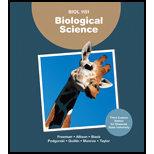
Concept explainers
What distinguishes a morphospecies?
a. It has distinctive characteristics, such as size, shape, or coloration.
b. It represents a distinct branch in a phylogeny of populations.
c. It is reproductively isolated from other species.
d. It is a fossil from a distinct time in Earth history.
Introduction:
Morphology confers to the study of the structures of the organisms, involving its function, in order to classify organisms. Furthermore, morphology can be classified as functional morphology, molecular morphology, anatomy morphology, comparative morphology, and several other branches of morphology.
Answer to Problem 1TYK
Correct answer:
A morphospecies has distinct characteristics including color, shape, and size. The concept of the morphospecies is helpful in the identification of the morphologic features of the organisms.
Explanation of Solution
Explanation/justification for the correct answer:
Option (a) is given as distinction in the size, shape, and coloration. The term “morphospecies” have originated from morphology, which is used to indicate the difference in the body structure of the organisms; it could be color, size, or shape. It is based on the concept that isolated, independent gene flow results in the development of distinguished phenotypic features. Hence, Option (a) is correct.
Explanation for incorrect answer:
Option (b) is given as the representation of the population phylogeny. However, morphospecies is a term used to describe different species rather than a defining a branch in phylogenetic population (relation to the ancestors). So, it is a wrong answer.
Option (c) is given as reproductive isolation from another species. A morphospecies cannot be distinguished based on the reproductive isolation as none of the two different species can reproduce together. So, it is a wrong answer.
Option (d) is given as the presence of the fossil from some distinct time in the history of earth. A fossil is a preserved form of any individual, which is formed over a long period of time. So, it is a wrong answer.
Hence, options (b), (c), and (d) are incorrect.
Thus, the morphospecies can be distinguished based on its size, shape, and color.
Want to see more full solutions like this?
Chapter 24 Solutions
BIOLOGICAL SCIENCE >C<
- Which situation would most likely lead to allopatric speciation? a. A flood causes the formation of a new lake. b. A storm causes several large trees to fall down. c. A mutation causes a new trait to develop. d. An injury causes an organism to seek out a new food source.arrow_forwardWhich best describes a branch point in a phylogenetic tree?a. a hypothesisb. new lineagec. hybridizationd. a matingarrow_forwardWhich assumption of cladistics is stated incorrectly? a. Living things are related by descent from a common ancestor. b. Speciation can produce one, two, or three new species. c. Traits change from one state to another. d. The polarity of a character state change can be determined.arrow_forward
- Using the phylogeny, which statement best explains the evolutionary relationship of birds and bats? A. C is an example of divergent evolution shows a common ancestor. B. C is an example of convergent evolution does not show a common ancestor. C. A and B are examples of analogous structures derived from a common ancestor. D. A and B are examples of homologous structures that are not derived from a common ancestor.arrow_forwardConstruct a phylogeny in the form of a simple cladogram with the ten candies shown on slide A. The tree must include synapomorphies. Once your tree is compete, make another one incorporating the new “taxa” on slide B.barrow_forwardWhat pattern of speciation is illustrated by the development of the allopolyploid species? A. allopatric speciation B. sympatric speciation C. cladopatric speciation D. anapatric speciationarrow_forward
- Where in a phylogenetic tree would you expect to find the organism that had evolved most recently? a. at the base b. within the branches c. at the nodes d. at the branch tipsarrow_forwardWhere on the tree did the amniotic egg evolve? Group of answer choices C A D E Barrow_forwardA. Which two alien species are likely to be the most related? Why? B. Which two alien species are likely the least related? Why? C. In this cladogram, how many times have lineages diverged? D. On your cladogram, circle the most recent common ancestor of the pingests and persnippys.arrow_forward
- What do scientists use to apply cladistics? a. homologous traits b. homoplasies c. analogous traits d. monophyletic groupsarrow_forwardBelow is a type of evolutionary tree. Which species is O closely related to?arrow_forwardChoose the words that make the sentence most accurate. When reconstructing phylogenies, you should use ___________ traits because they are _______________. a. homologous; similar due to common ancestry. b. homoplastic; similar due to common ancestry. c. homoplastic; similar due to environmental constraints. d. homologous; similar due to environmental constraints.arrow_forward
 Concepts of BiologyBiologyISBN:9781938168116Author:Samantha Fowler, Rebecca Roush, James WisePublisher:OpenStax College
Concepts of BiologyBiologyISBN:9781938168116Author:Samantha Fowler, Rebecca Roush, James WisePublisher:OpenStax College
